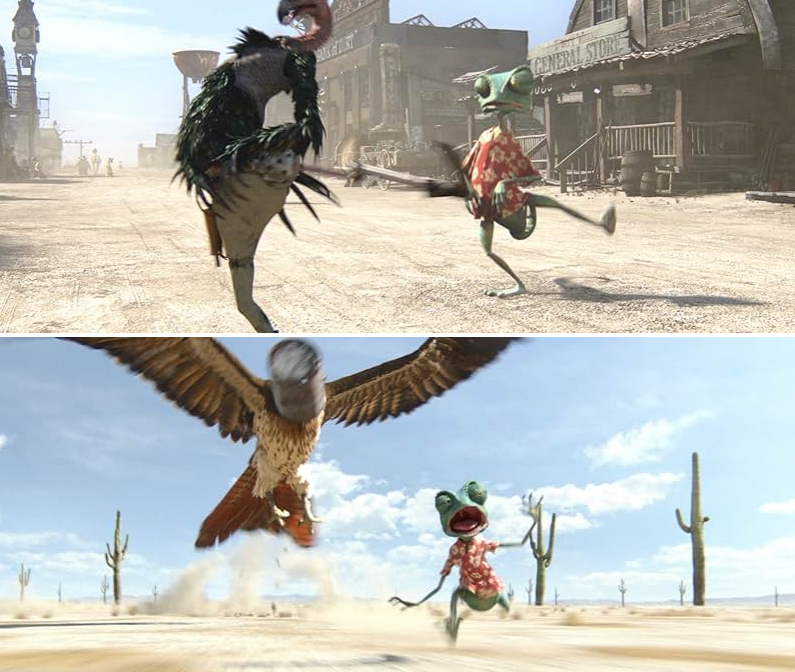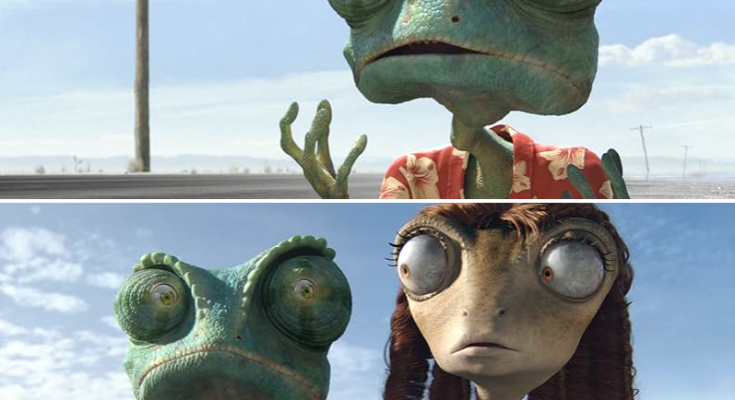
This image is split into two horizontal sections, both showing scenes from the animated movie “Rango” — a critically acclaimed 2011 CGI-animated film produced by Nickelodeon Movies and directed by Gore Verbinski. The film is known for its unique visual style, quirky characters, and spaghetti Western-inspired storyline. Below is a detailed breakdown of what’s happening in each part of the image, as well as the broader cinematic and thematic context:
Top Half:
The top portion of the image features Rango, the main character of the film. Rango is a chameleon, vividly animated with bulging eyes, expressive facial features, and textured green skin. His appearance alone carries a lot of character and charm. He wears a red Hawaiian shirt, which is one of his signature wardrobe pieces throughout the movie. The shirt adds to his whimsical and slightly out-of-place personality, especially within the rugged desert setting he finds himself in.
Rango’s expression in this frame is one of confusion or perhaps contemplation. He holds up his hand in a gesture that implies he’s either trying to explain something or questioning something he’s just heard or seen. His surroundings are sparse — a barren desert landscape stretches behind him with a single, skinny telephone pole breaking the sky, emphasizing the emptiness and isolation of the setting. The color palette here is dusty, washed-out blues and browns, effectively conveying the heat and dryness of the desert.
Bottom Half:
In the lower section of the image, Rango is joined by Beans, the female lead in the film. Beans is a desert iguana, designed with equally exaggerated and expressive features. Her character is brave, headstrong, and intelligent — a perfect foil to Rango’s chaotic, bumbling hero. Her appearance is marked by big, glassy eyes, a thin neck, and a rather stern expression in this frame. She wears a Victorian-style dark blue dress with a white collar, highlighting the film’s Western aesthetic with a twist of frontier fashion.
Rango is standing beside her with a neutral or slightly concerned look, while Beans looks ahead with a sense of focus or determination. The background remains a dry desert landscape with pale blue skies and minimal vegetation. This stark environment is a recurring visual theme throughout the movie, reinforcing the hardships and survival elements of the Wild West setting.
Characters and Symbolism:
- Rango is a character caught between two worlds — fantasy and reality. He starts off as a lonely pet chameleon who dreams of being a hero, often practicing imaginary scenes in his tank. When he ends up stranded in the Mojave Desert, he adopts the persona of a tough gunslinger named “Rango” in a dusty town called Dirt. His journey is not just about survival, but also about self-discovery and heroism. His awkward but endearing mannerisms reflect his inner turmoil as well as his comedic charm.
- Beans, in contrast, is grounded in reality. She’s fiercely independent and serves as the moral compass of the film. Her seriousness in this image contrasts with Rango’s typical whimsical behavior, signaling the balance between illusion and truth that defines their relationship and the narrative as a whole.
Visual Style and Cinematography:
“Rango” is notable for being one of the few mainstream animated features that doesn’t conform to the glossy, family-friendly aesthetic of Pixar or DreamWorks. Instead, the film embraces gritty textures, muted color palettes, and detailed environments. The characters are not traditionally cute or sleek; they are awkward, often grotesque, and full of life — giving the movie a kind of anti-Disney vibe that resonates with more mature themes despite being an animated feature.
- The character design is highly detailed and expressive. The animators used a technique called “emotion capture” where the voice actors, including Johnny Depp (Rango), acted out scenes physically to help inform the animation.
- The backgrounds are meticulously crafted to convey the harshness and desolation of the desert, playing into classic Western tropes with a surreal twist. In both panels of the image, you can see this desolate environment providing a dramatic and cinematic backdrop.
- The lighting is naturalistic, often mimicking the stark sunlight of desert afternoons. The sky appears bleached under the intensity of the sun, and shadows are kept soft but present, contributing to the film’s realism.
Themes Reflected in This Image:
This still captures several of the movie’s core themes:
- Identity and Transformation: Rango’s out-of-place Hawaiian shirt and puzzled expression highlight his journey from an actor of fake roles to a true hero.
- Isolation and Belonging: The barren landscape mirrors the emotional void Rango starts with, while Beans represents a connection to reality and responsibility.
- Comedy Meets Drama: The odd proportions and serious expressions combine comedy with genuine stakes — a blend that defines the film’s tone.
- Western Tropes: The image references classic Western duos — the lost stranger and the no-nonsense local — both set against an unforgiving frontier.
Final Thoughts:
This image is a compact visual representation of what makes Rango such a memorable and genre-defying film. The juxtaposition of Rango and Beans in these scenes showcases the film’s ability to balance humor, heart, and grit. The visuals communicate personality, narrative, and tone without needing a single word. For fans of animation, cinema, or Westerns, this film — and this frame — exemplifies how rich storytelling and unique design can come together to create something truly special.
Would you like me to create a movie-style caption or meme from this image too?



